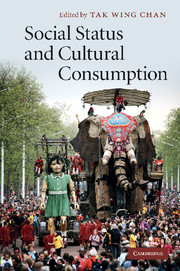Book contents
- Frontmatter
- Contents
- List of figures
- List of tables
- List of contributors
- Acknowledgments
- 1 Social status and cultural consumption
- 2 The social status scale: its construction and properties
- 3 Social stratification and musical consumption: highbrow–middlebrow in the United States
- 4 Bourdieu's legacy and the class–status debate on cultural consumption: musical consumption in contemporary France
- 5 Social status and public cultural consumption: Chile in comparative perspective
- 6 Social stratification and cultural participation in Hungary: a post-communist pattern of consumption?
- 7 Status, class and culture in the Netherlands
- 8 Social stratification of cultural consumption across three domains: music; theatre, dance and cinema; and the visual arts
- 9 Conclusion
- References
- Index
8 - Social stratification of cultural consumption across three domains: music; theatre, dance and cinema; and the visual arts
Published online by Cambridge University Press: 07 May 2010
- Frontmatter
- Contents
- List of figures
- List of tables
- List of contributors
- Acknowledgments
- 1 Social status and cultural consumption
- 2 The social status scale: its construction and properties
- 3 Social stratification and musical consumption: highbrow–middlebrow in the United States
- 4 Bourdieu's legacy and the class–status debate on cultural consumption: musical consumption in contemporary France
- 5 Social status and public cultural consumption: Chile in comparative perspective
- 6 Social stratification and cultural participation in Hungary: a post-communist pattern of consumption?
- 7 Status, class and culture in the Netherlands
- 8 Social stratification of cultural consumption across three domains: music; theatre, dance and cinema; and the visual arts
- 9 Conclusion
- References
- Index
Summary
Introduction
In Chapter 1 of this volume, we have outlined three widely discussed arguments concerning the social stratification of cultural consumption: that is, what we have labelled as the ‘homology’, the ‘individualisation’ and the ‘omnivore–univore’ arguments. In our own previous work (Chan and Goldthorpe, 2005, 2007d, e) we have examined the validity of these arguments in the light of analyses of cultural consumption in England in three different domains: that is, in music, in theatre, dance and cinema, and in the visual arts. Through this work we have sought to make some advance on previous research in two main ways.
First, we have recognised that insofar as the focus of interest is on cultural consumption, then this must be studied as directly as possible, and that patterns of consumption cannot be reliably inferred from data that amount to no more than individuals' expressions of their cultural tastes and preferences. Reliance on the latter may well give an exaggerated or distorted idea of the extent of consumption (cf. Chan and Goldthorpe, 2007b). We have based our own analyses on data from the Arts in England Survey, carried out in 2001 (for further details see Skelton et al., 2002), which involved face-to-face interviews with a national sample of persons aged 16 and over, and which aimed to assess the extent of their attendance at cultural events and their participation in cultural activities, very broadly understood. The degree to which activities within particular domains are differentiated in this survey is often not as great as we would wish but this is more than compensated for by its comprehensive coverage and by the range of socio-demographic information that was also collected.
- Type
- Chapter
- Information
- Social Status and Cultural Consumption , pp. 204 - 231Publisher: Cambridge University PressPrint publication year: 2010
- 2
- Cited by



